Today, the Internet of Things is becoming an integral part of more and more industries. Security and smart homes, transportation, and automotive – you can find IoT everywhere. And the statistics prove that its popularity is not about to stop growing. By 2030, global IoT revenue is expected to reach more than $200 billion, compared to less than $70 billion in 2019.
On top of that, modern cloud services based on the Platform-as-a-Service (PaaS) model open up numerous opportunities to grow and scale your IoT business. In particular, IoT allows collecting all data in one place and processing it more effectively. Thus, you can make more result-driven decisions and design more effective business processes.
But here’s the thing: which provider should you opt for?
When mentioning cloud-based platforms for IoT, you probably recall Amazon Web Services (AWS) and Microsoft Azure. These two giants are the most popular options for IoT solutions. Not surprisingly, they have the most significant market share. Together with Google Cloud, AWS and Azure hold 80% of the whole IoT public cloud market.
But which one will better suit your individual business needs? Let’s try to find out.
Several successful projects have given Wellnuts profound expertise in building scalable, data-driven IoT solutions. Let us share with you some helpful insights. This post will explain the specifics of AWS IoT vs Azure IoT revealing their standard and distinctive features. Also, we will talk about the basics of IoT platforms, their benefits, core functions, and architecture.
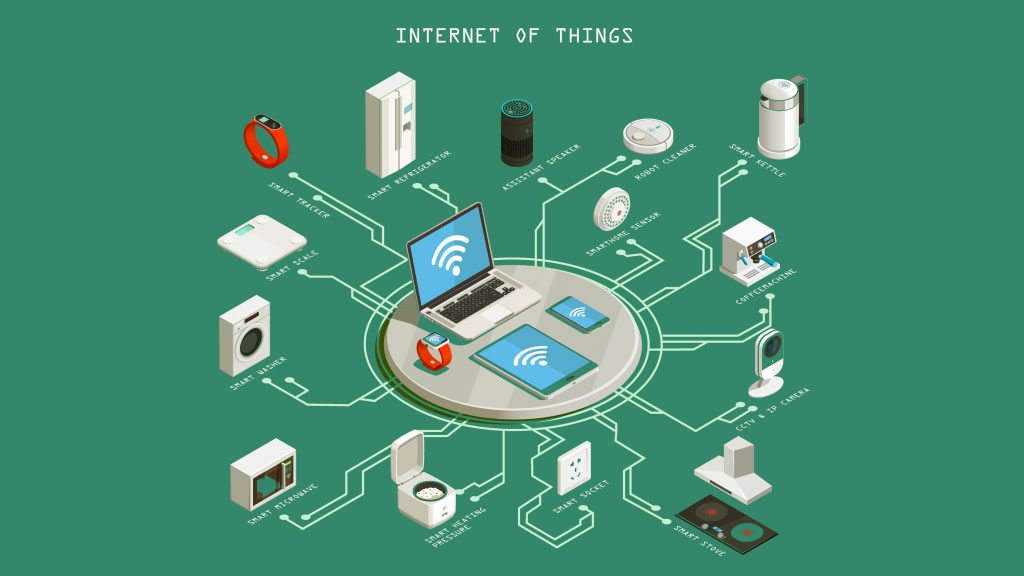
IoT Platforms Explained
Before we start to compare the quality and usability of AWS IoT vs Azure IoT, let’s define the overall meaning and purpose of such platforms. It will help you better understand the Internet of Things and how to use this solution for your business goals.
So what is an IoT platform, and how can you benefit from it? Time to make it clear.
What is IoT Platform
Internet of Things (IoT) is an advanced technology that involves a network of physical objects like vehicles, electronic systems, and other devices. They connect with others via the Internet. It works with the help of embedded sensors and specialized software to control and manage interactions. This solution allows transferring and exchanging data without human resources and manual operations involvement.
IoT has changed the game in multiple industries. The technology is already widely used for connected cars, smart homes, security systems, GPS fleet tracking, identity authentification, etc.
To implement IoT solutions and effectively use them for your business objectives, you need a service making the technology available.
Thus, an IoT platform is an on-premises or cloud-based solution that manages the connections between various devices and helps facilitate development processes. In particular, IoT platforms ensure seamless data collection, well-established interactions, and smooth device communication.
Why IoT Platforms are Beneficial
Internet of Things (IoT) is an advanced technology that involves a network of physical objects like vehicles, electronic systems, and other devices. They connect with others via the Internet. It works with the help of embedded sensors and specialized software to control and manage interactions. This solution allows transferring and exchanging data without human resources and manual operations involvement.
Cloud-based IoT solutions can be even more beneficial since they are relatively inexpensive and can handle numerous operations without requiring much effort.
Here are the most significant advantages of IoT platforms like AWS and Azure.
- Well-established connectivity. A ready-made solution will ensure connections between your software, hardware, and databases.
- Cost-effectiveness. Third-party providers’ services are much cheaper than building an on-premises platform.
- Data storage. An IoT platform will provide a secure and convenient environment for storing your data.
- Easy access to data reports and insights. Dashboards will ensure at-a-glance access to all required information.
- Fast deployment. Multiple integrations and streamlined device management will make your life easier.
How IoT Platforms Work
Architecture
Any ready-made IoT solution is based on PaaS (Platform as a Service) model. It’s a development and deployment cloud-based environment providing all necessary resources and tools over the Internet. PaaS is the core solution for realizing IoT technology, ensuring the effective functioning of its main components.
An IoT system’s architecture consists of five essential layers: IoT devices (hardware), communication, backend, applications, and security. Each module is responsible for individual tasks and ensures a healthy, well-functioning, and protected environment.
- The sensors and actuators layer provides data transmission across physical х and the creation of necessary electrical signals.
- The communication layer controls the connection of devices to the network. Gateway systems convert data to digital format.
- The backend layer performs numerous functions related to software and databases, including third-party integrations.
- The applications layer provides seamless interactions of the apps.
- The security layer protects all these processes from potential risks.
Here’s what the architecture of the Azure IoT platform looks like:
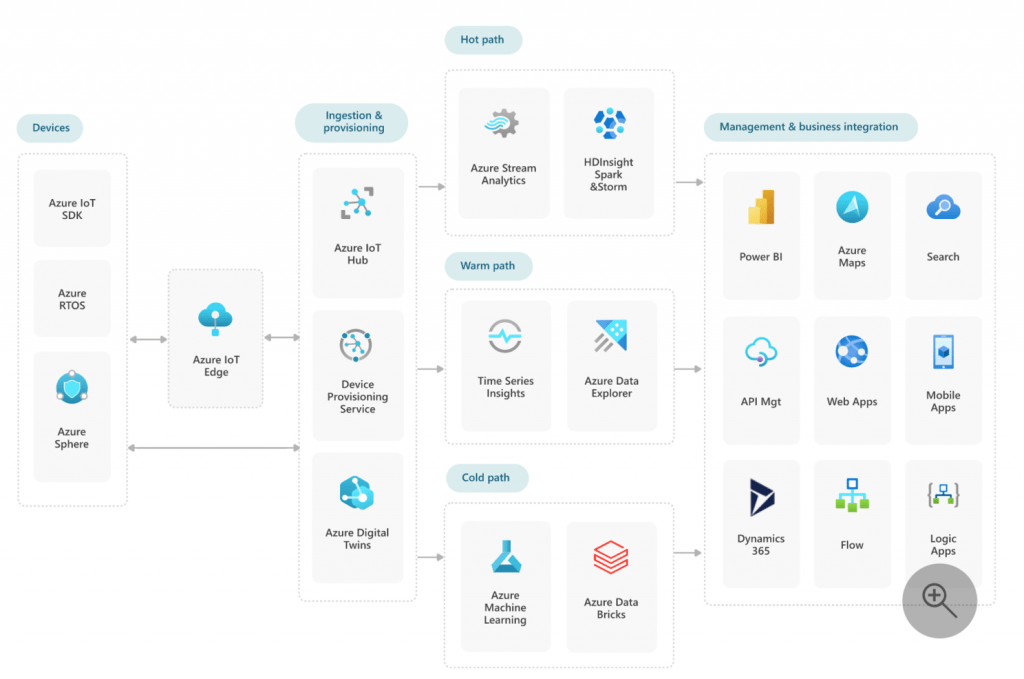
And here’s the architecture of the AWS IoT platform:
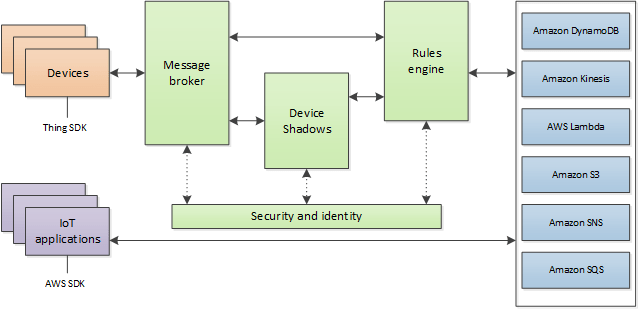
Core Features
Among the numerous features offered by IoT service providers, the following are the most critical.
- Device management. You can register and control your “things” (devices), make health checks, track performance, and store attributes.
- Connectivity. The connection between the cloud and connected devices allows you to send and receive data, ensure uninterrupted remote access, and use specific protocols (HTTP, MQTT, etc.)
- Data collection. You can collect and process data from the devices. Also, an IoT platform should provide robust analytical tools and dashboards. They ensure seamless access to the required information.
- Configuration management. Everything should be controllable and constantly available, from data analytics to management parameters. The provider should allow you to monitor all interactions and changes within the system.
- Integrations. Third-party integrations provide access to all necessary apps and tools. It streamlines all business processes and customizes the IoT platform’s environment to your needs.
Who Is Who: IoT Market Specifics
Now you know how IoT platforms work and why they may benefit your business. Let’s get closer to the main question. Which service provider should you opt for?
Well, your choice is not as great as you might think. The IoT market is skyrocketing as the expected CAGR growth by 2028 is almost 25%. However, there are not so many leading players. Their number has hardly changed since 2019.
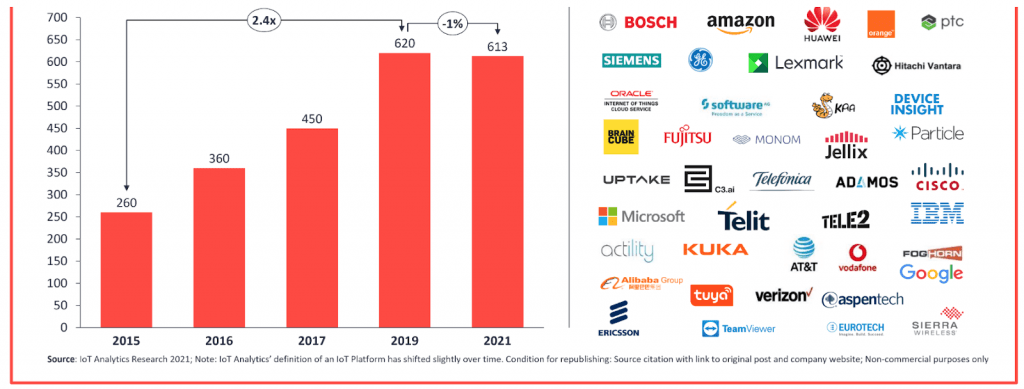
Azure and AWS are not the only IoT providers worth your attention despite their undeniable leadership. You may also consider platforms like Google Cloud, Oracle, IBM Watson, ThingWorx, Salesforce IoT Cloud, Cisco, etc. However, in this post, we will focus on AWS vs Azure IoT, true giants in the Internet of Things world.
Microsoft Azure
Since 2016, Microsoft has launched numerous IoT solutions, including its own operating system. It’s an open-source platform offering scalable and secure services. Azure IoT serves multiple industries, including the automotive, energy sector, retail, healthcare, etc.
One of the main benefits of Microsoft IoT services is its full-fledged solution with all components you may need. To name a few, these are IoT Hub, IoT Edge, IoT Central, IoT Digital Twins, and many more.
With Microsoft Azure, you can get a full package solution that includes robust security, manageable databases, seamless integrations, and more.
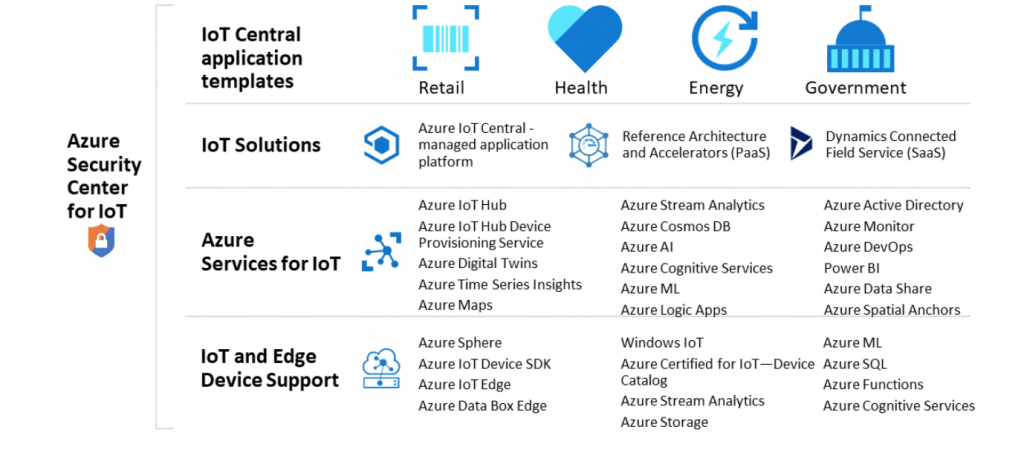
Amazon Web Services (AWS)
Amazon offers dozens of comprehensive services making advanced technology affordable and convenient. Their IoT cloud platform became available in 2015 and has been one of the market leaders ever since. One of AWS IoT Core’s main benefits is that you don’t have to manage your servers when connecting your devices to the system.
On top of that, AWS IoT provides multiple protocols to enhance connectivity. You can also use other Amazon services (Kinesis, Dynamo DB, CloudWatch, etc.) combined with IoT solutions.
Finally, AWS ensures high-level security thanks to end-to-end encryption, offers outstanding Machine Learning capabilities, and provides numerous edge computing solutions.

Azure IoT vs AWS IoT: Benefits and Drawbacks
Microsoft and Amazon are the most popular vendors providing cloud infrastructure services. According to Statista, AWS controls 33% of the entire market, while Azure accounts for 22%. Both platforms are extremely successful, offer proven reliability and provide many valuable features. However, there is a critical difference between IoT AWS vs Azure.
Key Difference
Let’s specify the advantages you will gain and the disadvantages you may face when deciding to opt for one of these solutions.
AWS IoT Benefits
Here are the most significant advantages of Amazon IoT services.
- High connectivity
- Many SDKs for various IoT needs
- Scalability
- AI and machine learning capabilities
- Numerous cloud solutions (databases, storage, edge computing, etc.)
- Multiple device qualification partners
AWS IoT Drawbacks
You may have to cope with particular challenges when opting for the AWS solution despite all these advantages. The following are the most significant:
- Certain AWS IoT services may be too costly, especially for beginners and small businesses.
- AWS IoT Core is a complex set of multiple tools, services, and approaches. So if you are a newcomer to the Internet of Things technology, it may be hard for you to learn the platform’s specifics.
Azure IoT Benefits
Here are the most solid pros you will gain if choosing Azure IoT solution.
- An operating system for IoT management
- Multiple tools for edge and device support
- Many cool features like Digital Twins, Accuweather, Azure Maps, and more
- Intuitive interface
- Flexible pricing models
- Reliable security system
Azure IoT Drawbacks
Just like AWS, the Azure IoT system has its downsides too. The most challenging ones are the following:
- Azure offers fewer free services for subscribers.
- The IoT system lacks comprehensive documentation.
- It could be too expensive for individual use.
- Azure doesn’t have as powerful AI and machine learning capabilities as AWS.
Pricing Difference
In Azure IoT vs AWS IoT comparison, we cannot miss such an influential factor as the service’s price. It’s worth noting that the availability depends on the pricing plan that suits your business needs best.
AWS Price
AWS service price depends on four key factors:
- Connectivity
- Messaging
- Rules engine
- Device shadow and registry updates
Thus, the price is custom and equally depends on all of the factors above. Fortunately, AWS offers a convenient calculator that helps the clients estimate the services’ cost.
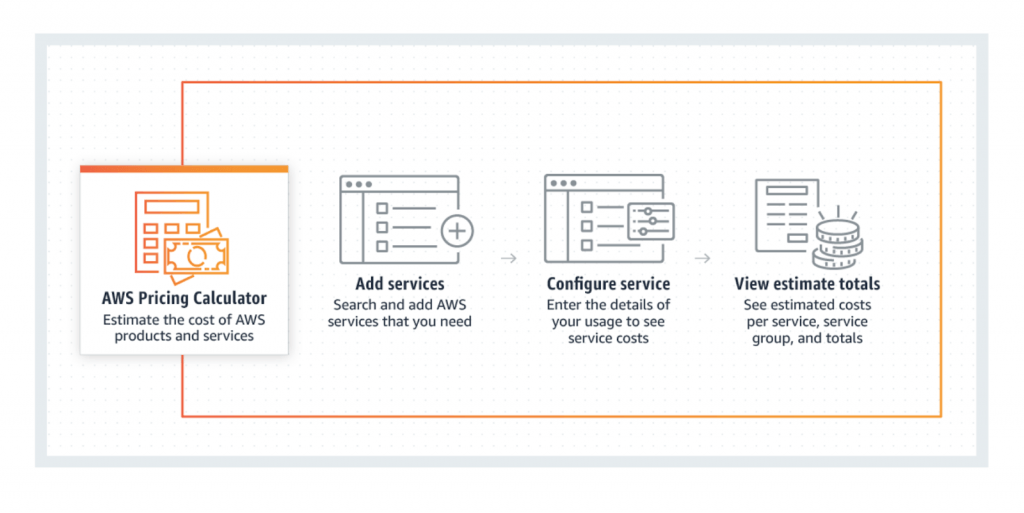
Azure Price
Azure price is quite flexible and generally depends on the number of messages you send. There are two possible pricing plans: basic and standard. The basic plan starts at $10 per month with 400,000 messages per IoT Hub unit. The standard package, in turn, offers 8,000 free messages per day.
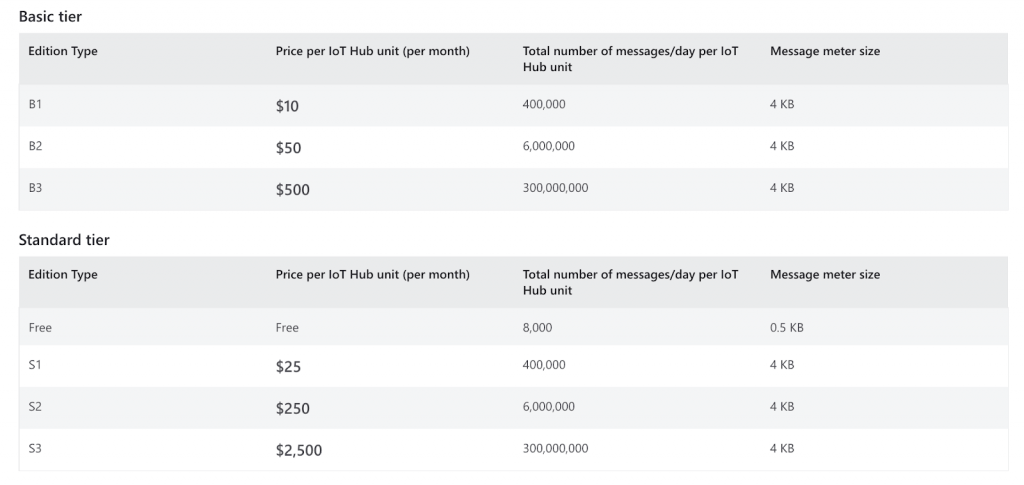
Features Difference
And finally, to complete our Azure IoT Core vs Azure IoT Hub comparison, let’s focus on one of the essential aspects that determine a good service provider: its features.
| Feature | Azure IoT platform | AWS IoT platform | |
| Device management | Remote device health monitoring Pipeline support for data delivery | Good control over device state Lack of data delivery support | |
| User authorization and authentification | Seamless authorization and authentification processes | ||
| Protocols | Supports HTTPS, AMQP, and MQT protocols | Supports HTTPS, AMQP, and MQT Doesn’t support HTTP | |
| SDKs, frameworks, and integrations | All widespread programming languages, SDKs, and APIs are available | ||
| Edge computing | Uses more universal FreeRTOS and Greengrass tools | Uses less flexible Azure IoT Edge | |
| Data storage and identity management | Stores data with Offers Third Registry | Stores data with Azure IoT Hub | |
| Security systems | Use Transport Layer Security protocol for data encryption | ||
| Scalability | Both platforms are scalable | ||
| Interface and dashboards | The interface and dashboards may be harder to understand for beginners | The interface is intuitive and user-friendly | |
| Device communication | Connects devices to IoT platform via a rule engine | Uses messages with timestamps and Twin Device for connection |
Azure vs AWS: the Final Round
So what is left to say to resolve Azure IoT vs AWS IoT dispute? Some say that AWS offers more comprehensive and advanced services. Meanwhile, Azure is easier to start with and more convenient for small businesses. However, this statement is also quite ambiguous and depends on many factors.
Both platforms offer numerous robust features, reliable security systems, excellent services, and top-notch solutions. So whichever you choose, it may be a perfect match. Or not if it doesn’t meet your actual business goals.
Therefore, the best solution will be to let professionals help you make the right decision. We at Wellnuts know our business well and are ready to help you out. Our company delivers scalable data-driven solutions and provides a wide range of IoT services. In particular, we deal with data processing platforms, geolocation systems, IoT management apps, cloud solutions, and more.
Our specialists are equally aware of Azure and AWS IoT specifics. So get in touch, and we will help you make a wise choice!
Frequently Asked Questions
What Does an IoT Platform Do?
An IoT platform provides you with all necessary services to help you develop, deploy, and manage the interactions between your connected devices. Also, it ensures seamless data receipt and delivery. Cloud-based solutions like AWS or Azure allow you to use numerous robust features and integrations. Thus, you can enhance the security, speed, and efficiency of connections between your IoT devices.
What Are the Components of an IoT Platform?
A PaaS-based IoT platform has a specific multilayer architecture consisting of several core blocks. Such an approach makes the platform more scalable and effective. The architecture of an IoT solution may vary. However, usually, it consists of the following essential components:
- Sensors and actuators
- Devices communication
- Backend
- Applications
- Security system
Is AWS IoT Better than Azure IoT?
AWS IoT may better suit those looking for a more comprehensive, sophisticated, and scalable approach. However, Azure also offers multiple helpful features, tools, and services. On top of that, many claim the Azure IoT system to be more user-friendly and easy to learn, which makes it a preferable choice for beginners.
Ready to talk? Contact us: ask@wellnutscorp.com



